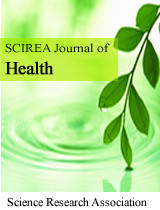COVID-19 PREVENTIVE PRACTICE AND EXPERIENCE OF VIOLENCE AGAINST WOMEN AND GIRLS IN NIGERIA
DOI: 10.54647/pmh33178 92 Downloads 15989 Views
Author(s)
Abstract
Introduction: This study aimed to assess COVID-19 preventive measures and violence against women and girls and determine the factors that contribute to COVID-19 preventive practices and violence against women and girls in Nigeria.
Method: A descriptive cross-sectional design was used for this study. Data was collected from 413 women/girls with age >18 years using a semi-structured interviewer-administered questionnaire The data were analyzed using descriptive and inferential statistics. P value <0.05 was considered significant.
Results: Almost all 410 (99.2%) of the women were aware of the COVID-19. The majority 313 (75.8%) revealed that television was their main sources of information. Also, regular hand washing, 390 (94.4%) and use of face masks, 322 (77.2%) were the most common COVID-19 preventive measures practiced by the respondents. However, most 305 (73.8%) of the respondents had poor COVID-19 preventive practice. Further results revealed that physical violence 338 (81.8%) was the most common type of violence known. Thirty-one (7.5%) of the women claimed they had experienced at least one type of violence as a result of staying at home during the COVID-19 lockdown. There was a significant relationship between the COVID-19 preventive measures and violence against women and girls (χ2 = 19.59; p= 0.001)
Conclusion: The COVID-19 preventive practices such as lockdown enforcement contributes to violence against women and girls.
Keywords
COVID-19 Preventive Practice, Factors, Gender-based Violence, Nigeria.
Cite this paper
Ibekwe Ogechukwu C. MPH, BNSC., Kareem Abiodun J. FMCPaed, MPH, MBChB., Akpoti Okehi O. MBBS., Ogunromo Ayodele Y. MPH, BSc,
COVID-19 PREVENTIVE PRACTICE AND EXPERIENCE OF VIOLENCE AGAINST WOMEN AND GIRLS IN NIGERIA
, SCIREA Journal of Health.
Volume 5, Issue 6, December 2021 | PP. 108-122.
10.54647/pmh33178
References
| [ 1 ] | World Health Organization. WHO announces COVID-19 outbreak a Pandemic Available from: http://www.euro.who.int/en/health-topics/health-emergencies/coronaviruscovid19/ news/news/2020/3/who-announces-covid-19-outbreak-a-pandemic. Accessed 20-7-2021. |
| [ 2 ] | WHO. Coronavirus disease 2019 (COVID-19) situation report – 23. Geneva, Switzerland: World Health Organization. 2020. https://www.who.int/docs/default-source/coronaviruse/situation-reports/20200212-sitrep-20200223- ncov.pdf?sfvrsn=20200241e20200219fb20200278. Accessed 15-5-2021. |
| [ 3 ] | IPPF. Novel Coronavirus COVID-19. Infection Prevention and Control. 2020. https://www.ippfeseaor.org/sites/ippfeseaor/files/202004/Infection%20Prevention%20and%20Control%20-%20COVID%2019%20 %20Resources%20%2002042020%20%28wecompress.com%29.pdf. Accessed 7-3-2021. |
| [ 4 ] | WHO. COVID-19 and violence against women: What the health sector/system can do. 2020. https://www.who.int/reproductivehealth/publications/emergencies/COVID-19-VAW-full-text.pdf. Accessed 12-6-2021. |
| [ 5 ] | Chandra-Mouli V. Amin A. Violence against women and girls: Forms, levels, consequences, causes, and growing commitment to address it. Department of Reproductive Health and Research, World Health Organization. 2020. http://archive.ipu.org/splz-e/dhaka14/mouli.pdf. Accessed 15-7-2021. |
| [ 6 ] | UN Women. COVID-19 and ending violence against women and girls. 2020. https://reliefweb.int/sites/reliefweb.int/files/resources/brief-prevention-violence-against-women-and-girls-and-covid-19-en.pdf. Accessed 18-6-2021. |
| [ 7 ] | Ellsberg M. Arango DJ. Morton M. Gennari F. Kiplesund S. Contreras M, et al. Prevention of Violence against Women and Girls: What Does the Evidence Say? The Lancet. 2014; 385: 1555-1566. doi: 10.1016/S0140-6736(14)61703-7. |
| [ 8 ] | WHO. Global and regional estimates of violence against women. Sexual and Reproductive Health. 2015. https://www.who.int/reproductivehealth/publications/violence/9789241564625/en/. Accessed 20-6-2021. |
| [ 9 ] | Abrahams N. Devries K. Watts C. Pallitto C. Petzold M. Shamu S, et al. Worldwide prevalence of non-partner sexual violence: a systematic review. Lancet. 2014; 383: 1648–54. doi: 10.1016/S0140-6736(13)62243-6. |
| [ 10 ] | Feldman-Jacobs C. Clifton D. Female genital mutilation/cutting: data and trends, update 2014. Washington, DC: Population Reference Bureau. |
| [ 11 ] | Lee-Rife S. Malhotra A. Warner A. Glinski AM. What works to prevent child marriage: a review of the evidence? Stud Fam Plann. 2012; 43(4): 287–303. Doi: 10.1111/j.1728-4465.2012.00327.x. PMID: 23239248. |
| [ 12 ] | OSG. Oyo State Government. Population and Local Government Area and LCDAs. 2019. https://oyostate.gov.ng/ |
| [ 13 ] | Arifalo SF. Ayilaran CI. Effects of micro-credit scheme on agricultural production among members of farmers development union, Oyo State, Nigeria. Nigerian Journal of Agricultural Economics. 2012; 3(1): 59 – 68. Doi: 10.22004/ag.econ.267823. ISSN: 0794-4748. |
| [ 14 ] | LitCaf. Ibadan History. 2016. https://litcaf.com/ibadan-history/ |
| [ 15 ] | Suresh KP. Chandrashekara S. Sample size estimation and power analysis for clinical research studies. J Hum Reprod Sci. 2012; 5:7-13. |
| [ 16 ] | Le Maason V. Benoudiji C. Reyes SS. Bernard G. Violence against women and girls and resilience: Links, impacts and perspectives from the Chadian Context. 2015. Available from https://reliefweb.int/sites/reliefweb.int/files/resources/12011.pdf. Accessed 20-7-2021. |
| [ 17 ] | Ngozika A. Obi-Ani, Anikwenze C. Isiani MC. Social media and the COVID-19 pandemic: Observations from Nigeria. Cogent Arts and Humanities, 2020; 7:1. Doi: 10.1080/23311983.2020.1799483. |
| [ 18 ] | Olapegba PO. Ayandele O. Kolawole SO. Oguntayo R. Gandi JC. Dangiwa AL, et al. (2020). A preliminary assessment of novel Coronavirus (COVID-19) knowledge and perceptions in Nigeria. 2020; doi: https://doi.org/10.1101/2020.04.11.20061408. |
| [ 19 ] | Alnasser AHA. Al-Tawfiq JA. Al-Kalif MSH. Shahadah RFB. Almuqati KSA. Al-Sulaiman BSA, et al. Public knowledge, attitudes, and practice towards COVID-19 pandemic in Saudi Arabia: A web-based cross-sectional survey. Med Sci. 2021; 9:11. Doi: https://doi.org/10.3390/medsci9010011. |
| [ 20 ] | Nzaji K. Mwamba NG. Miema MH. Umba KN. Kangulu IB. Ndala BDB, et al. Predictors of non-adherence to public health instructions during the COVID-19 pandemic in the Democratic Republic of Congo. J Multidisciplinary Healthcare, 2020; 13: 1215-1221. |
| [ 21 ] | Hills SJ. Eraso Y. Factors associated with non-adherence to social distancing rules during the COVID-19 pandemic: A logistic regression analysis. BMC Public Health. 2021; 21(1): 352. Doi: 10.1186/s12889-021-10379-7. PMID: 33581734. |
| [ 22 ] | UN Women. A Framework to Underpin Action to Prevent Violence against Women. 2015. https://www.unwomen.org/en/digital-library/publications/2015/11/prevention-framework |
| [ 23 ] | Bakare MO. Asuquo MDA. Agomoh AO. Domestic violence and Nigeria women – A review of the present state. Nigerian Journal of Psychiatry. 2010; 8(2). Doi: 10.4314/njpsyc.v8i2.57620. |

